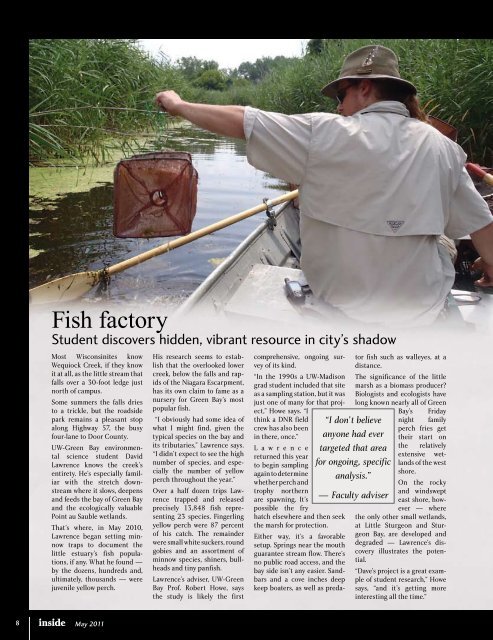TALKIN' - University of Wisconsin - Green Bay
TALKIN' - University of Wisconsin - Green Bay
TALKIN' - University of Wisconsin - Green Bay
You also want an ePaper? Increase the reach of your titles
YUMPU automatically turns print PDFs into web optimized ePapers that Google loves.
Fish factory<br />
Student discovers hidden, vibrant resource in city’s shadow<br />
Most <strong>Wisconsin</strong>ites know<br />
Wequiock Creek, if they know<br />
it at all, as the little stream that<br />
falls over a 30-foot ledge just<br />
north <strong>of</strong> campus.<br />
Some summers the falls dries<br />
to a trickle, but the roadside<br />
park remains a pleasant stop<br />
along Highway 57, the busy<br />
four-lane to Door County.<br />
UW-<strong>Green</strong> <strong>Bay</strong> environmental<br />
science student David<br />
Lawrence knows the creek’s<br />
entirety. He’s especially familiar<br />
with the stretch downstream<br />
where it slows, deepens<br />
and feeds the bay <strong>of</strong> <strong>Green</strong> <strong>Bay</strong><br />
and the ecologically valuable<br />
Point au Sauble wetlands.<br />
That’s where, in May 2010,<br />
Lawrence began setting minnow<br />
traps to document the<br />
little estuary’s fish populations,<br />
if any. What he found —<br />
by the dozens, hundreds and,<br />
ultimately, thousands — were<br />
juvenile yellow perch.<br />
8 May 2011<br />
His research seems to establish<br />
that the overlooked lower<br />
creek, below the falls and rapids<br />
<strong>of</strong> the Niagara Escarpment,<br />
has its own claim to fame as a<br />
nursery for <strong>Green</strong> <strong>Bay</strong>’s most<br />
popular fish.<br />
“I obviously had some idea <strong>of</strong><br />
what I might find, given the<br />
typical species on the bay and<br />
its tributaries,” Lawrence says.<br />
“I didn’t expect to see the high<br />
number <strong>of</strong> species, and especially<br />
the number <strong>of</strong> yellow<br />
perch throughout the year.”<br />
Over a half dozen trips Lawrence<br />
trapped and released<br />
precisely 13,848 fish representing<br />
23 species. Fingerling<br />
yellow perch were 87 percent<br />
<strong>of</strong> his catch. The remainder<br />
were small white suckers, round<br />
gobies and an assortment <strong>of</strong><br />
minnow species, shiners, bullheads<br />
and tiny panfish.<br />
Lawrence’s adviser, UW-<strong>Green</strong><br />
<strong>Bay</strong> Pr<strong>of</strong>. Robert Howe, says<br />
the study is likely the first<br />
comprehensive, ongoing survey<br />
<strong>of</strong> its kind.<br />
“In the 1990s a UW-Madison<br />
grad student included that site<br />
as a sampling station, but it was<br />
just one <strong>of</strong> many for that project,”<br />
Howe says. “I<br />
think a DNR field<br />
crew has also been<br />
in there, once.”<br />
L a w r e n c e<br />
returned this year<br />
to begin sampling<br />
again to determine<br />
whether perch and<br />
trophy northern<br />
are spawning. It’s<br />
possible the fry<br />
hatch elsewhere and then seek<br />
the marsh for protection.<br />
Either way, it’s a favorable<br />
setup. Springs near the mouth<br />
guarantee stream flow. There’s<br />
no public road access, and the<br />
bay side isn’t any easier. Sandbars<br />
and a cove inches deep<br />
keep boaters, as well as preda-<br />
“I don’t believe<br />
anyone had ever<br />
targeted that area<br />
for ongoing, specific<br />
analysis.”<br />
— Faculty adviser<br />
tor fish such as walleyes, at a<br />
distance.<br />
The significance <strong>of</strong> the little<br />
marsh as a biomass producer?<br />
Biologists and ecologists have<br />
long known nearly all <strong>of</strong> <strong>Green</strong><br />
<strong>Bay</strong>’s Friday<br />
night family<br />
perch fries get<br />
their start on<br />
the relatively<br />
extensive wetlands<br />
<strong>of</strong> the west<br />
shore.<br />
On the rocky<br />
and windswept<br />
east shore, however<br />
— where<br />
the only other small wetlands,<br />
at Little Sturgeon and Sturgeon<br />
<strong>Bay</strong>, are developed and<br />
degraded — Lawrence’s discovery<br />
illustrates the potential.<br />
“Dave’s project is a great example<br />
<strong>of</strong> student research,” Howe<br />
says, “and it’s getting more<br />
interesting all the time.”

















